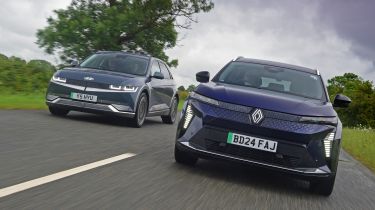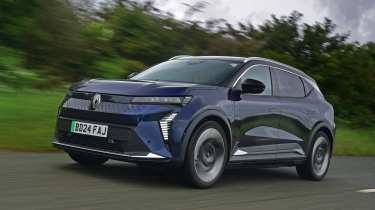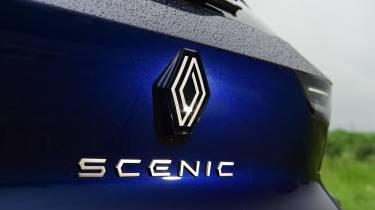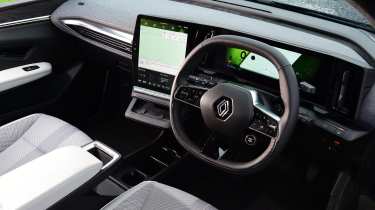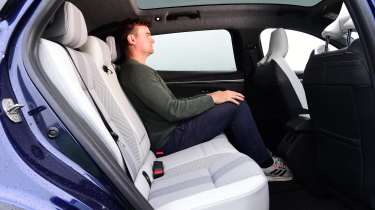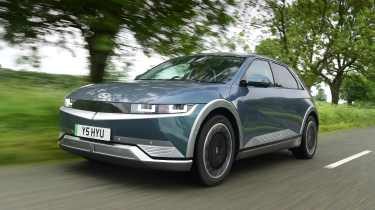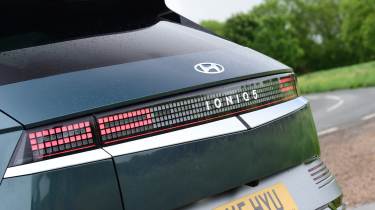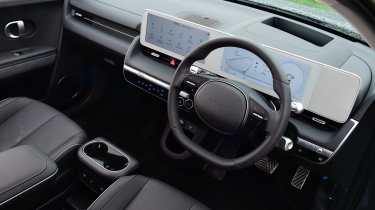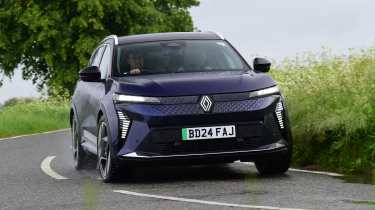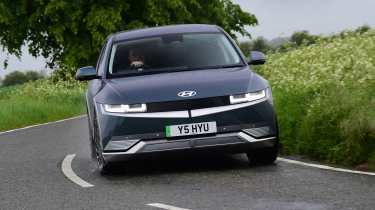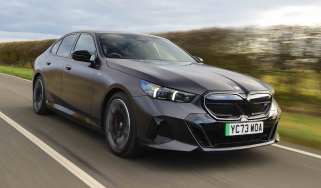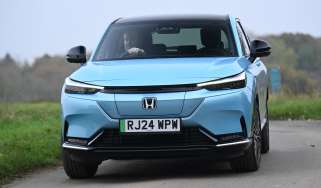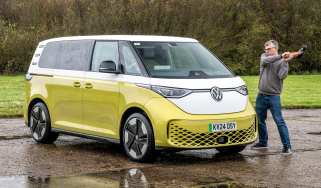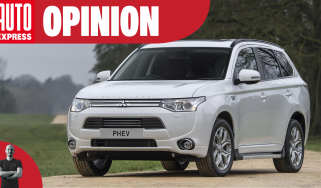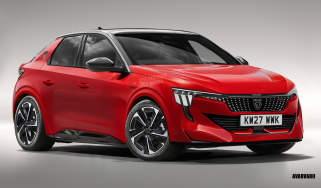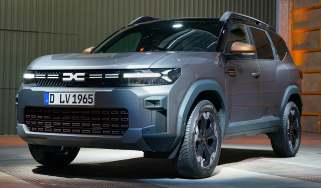Renault Scenic vs Hyundai Ioniq 5: eye-catching electric SUVs go head-to-head
Renault is resurrecting past names for its electric future. But how does the new Scenic compare against the Hyundai Ioniq 5?
What’s in a name? For many enthusiasts, recycling the badge of a past master can be unfathomable (think Ford and its controversial use of the Puma and Mustang nameplates), but what about those names that are familiar, but arguably aren’t quite so cherished by petrolheads?
It’s a gamble that Renault is making with the revival of the Scenic badge. But the new model isn’t another MPV like its predecessors; instead, the latest Renault Scenic is an all-electric SUV.
The new car is entering one of the busiest sectors when it comes to electrification, and here we’re pitching it against another vehicle that uses a badge with previous history. Hyundai only made one generation of Ioniq hatchback before it decided to use the badge for a range of electric models, and the first of those was the Ioniq 5 that we’re putting up against the Renault here. A previous award winner, the Ioniq 5 is at the cutting edge of EV tech, so the new Scenic will have its work cut out to make an impression in this test.
| Renault Scenic E-Tech Iconic Long Range | Hyundai Ioniq 5 Premium Long Range | |
| Price: | £45,495 | £49,945 |
| Powertrain: | 1x e-motor, 217bhp/ 87kWh battery | 1x e-motor, 225bhp/77kWh battery |
| 0-62mph: | 7.9 seconds | 7.3 seconds |
| Efficiency: | 3.5 miles/kWh | 3.6 miles/kWh |
| WLTP range: | 369 miles | 315 miles |
Renault Scenic
Competitive pricing has been a philosophy at Renault for a few years now, and the new Scenic E-Tech benefits from prices that undercut most similarly sized rivals. Here we’re testing the top-spec 87kWh Iconic Long Range, which, at £45,495, costs £1,450 less than the entry-level Ioniq 5 Premium with the Long Range battery.
Tech highlights
Back when the original Renault Scenic MPV was launched in 1996, it started life as a derivative of the Megane, and today the new Scenic SUV shares its running gear with the latest Megane E-Tech.
More reviews
Car group tests
- Ford Explorer vs Renault Scenic: we find the superior electric family SUV
- Renault Scenic vs Citroen C4 Picasso vs Ford C-MAX
In-depth reviews
Long-term tests
Road tests
Used car tests
Both use the Renault-Nissan-Mitsubishi Alliance’s CMF-EV platform, which also underpins the Nissan Ariya, and the Scenic has similar dimensions to the Japanese SUV – although that means it’s smaller than the Ioniq 5.
This platform is capable of sending power to all four wheels, but at launch the Scenic range is front-wheel drive, with the electric motor under the bonnet and the large 87kWh battery set between the axles to keep the centre of gravity low.
A kerbweight of 1,860kg is 75kg lighter than the Ioniq 5’s, which will help to boost the Scenic’s efficiency, while a maximum charging rate of 150kW is offered, although that’s 90kW less than the Hyundai is capable of.
Safety: Euro NCAP has awarded the Scenic a five-star safety rating, while the car’s percentage scores across the four categories are similar to those for the Ioniq 5. Standard safety kit includes 360-degree cameras on this top-spec Iconic model, front and rear parking sensors, lane-keep assist (which isn’t overly intrusive with its movements of the steering), blind-spot detection and autonomous emergency braking with pedestrian and cyclist detection.
On the road
A firm ride and so-so power delivery put a dampener on the Scenic’s driving ability.
Around town: At low speeds the Scenic is refined, while light steering boosts its manoeuvrability. The wheel has a strong self- centring tendency, although this is something you soon get used to. The 360-degree camera set-up is needed to help with reversing, because the view out the back is obscured by the narrow rear window and large headrests. The powertrain is responsive enough away from the lights, although the Scenic isn’t as punchy as some rival EVs from a standing start. However, a 0-62mph time of 7.9 seconds will be acceptable for most occasions.
A & B-roads: Press on a little harder, and the Scenic reveals a firm edge to its ride that shows up imperfections that the Hyundai simply glides over. We’d place some blame on the 20-inch wheels for this, although the suspension is also set up to cope with the weight of the Scenic’s battery – while this is a relatively light EV, there’s still at least 1.8 tonnes to manage.
That weight makes its presence felt in corners, where the Scenic feels slow to turn when compared with the Ioniq 5, while there’s plenty of body lean. Push harder out of a corner, and the front-drive set-up can see the unloaded inside wheel spin up, while torque steer makes its presence felt if you’re heavy with the accelerator.
Motorway: The Scenic is better as a cruiser, where there’s improved response from the electric motor once you’re up to speed. There’s some tyre roar at 70mph, but wind noise is barely noticeable, thanks in part to the acoustic glass that’s fitted to top-of-the-range Iconic models.
Ownership
The last Scenic MPV offered lots of room in a compact package, but the new E-Tech model is more compromised, courtesy of its SUV-derived design. That’s not to say that it’s tight inside, although the Hyundai does offer more interior space due to its larger overall dimensions. Cabin quality in the Renault is great, though, and maintains the company’s current ability to offer good quality and an upmarket feel at a competitive price. However, the driver’s plastic air vent controls look a little clunky in comparison with the rest of the cabin.
The interior features plenty of black plastic, but it’s broken up by the grey fabric trim on the dashboard, wood-effect inserts on the doors and some silver trim that spans across both, while the high-resolution displays look good. Our car’s light grey upholstery is the only option for the top-spec Iconic model – if you want black trim, then the Esprit Alpine is your only choice, while the entry-level Techno uses dark grey cloth. All three versions feature recycled materials inside, including leather-effect steering wheel trim that you can’t tell apart from the real thing.
On the face of it, the current Renault range looks pretty strong, but owners aren’t quite convinced about their cars. Our Driver Power survey places the company in 29th, only ahead of Audi, Fiat and MG in the manufacturer rankings. Hyundai wasn’t much further up the table, though, in a rather average 17th place.
Storage: Renault says there’s 38 litres of storage around the cabin, with a decent glovebox and a centre console that features 6.6 litres of space. This includes pull-out plastic dividers and a cup-holder, while above this sits a tray with the wireless smartphone charging pad.
The door bins are fine, with room for a drinks bottle if it’s canted forward to clear the armrest, while a flock lining stops items rattling around.
Practicality
Space is compromised a little by the car’s platform, but its boot capacity is good.
Rear space: Top-spec Iconic models feature a panoramic roof that is fitted with chromatic glass, which helps to save weight and improve headroom, because there’s no roller blind fitted.
Legroom is also generous in the back, but the front seats are mounted so low to the floor that there’s no foot space beneath them. Combine this with low rear-seat cushions, and there’s not much under-thigh support in the back. The middle seat is set high, too, but the backrest folds to reveal a multi-purpose armrest that has cup-holders, storage and smartphone slots for the two outer-seat occupants.
Boot: There’s a higher lip here than in the Hyundai, while the floor area isn’t as large, but the Scenic’s floor is lower, so overall volume is 18 litres larger, at 545 litres.
What to buy?
Which version we’d choose
- Powertrains: There are two options available in the Scenic. The entry-level model uses a 168bhp electric motor and the 60kWh battery from the Megane E-Tech, for a range of up to 260 miles. The Long Range option adds a 217bhp electric motor and a larger 87kWh battery. The best range quoted for this set-up is 379 miles.
- Trim: That figure is achieved by the Techno model, which has 19-inch alloys that will help to boost its efficiency, but is still decently specced. Above that sit the sporty Esprit Alpine and the plush Iconic model tested here.
- Our choice: Techno is great value and has the longest range with the 87kWh battery
Hyundai Ioniq 5
The Hyundai Ioniq 5 caused quite a stir when it arrived, and we crowned it our 2021 Car of the Year. Three years on, it’s still a distinctive family car, but prices are higher than they are for the Renault, with the Premium model – the entry point to the range – costing £46,495 with the 77kWh long-range battery. That’s £1,450 more than the highest-spec Scenic.
Tech highlights
The Ioniq name was originally used by a forgettable hatchback that rivalled the Toyota Prius, but taking that badge and adding the 5 suffix was just the start of Hyundai’s path to electrification. The Ioniq 5 is based on the company’s dedicated E-GMP electric car platform, which is also used by the Ioniq 6, Genesis GV60 and Kia’s EV6, EV9 and EV5.
All of these cars have their own unique look, and the Ioniq 5’s hatchback-style shape has plenty of interesting details, courtesy of the dot-matrix-style LED lights and sharp creases in the bodywork. However, while the Ioniq 5 looks like a hatch, it’s longer, taller and wider than the SUV-style Scenic here, and the three-metre wheelbase helps to create lots of space inside.
Under the skin is a typical EV skateboard-style chassis, with the batteries located in the floor between the front and rear axles. E-GMP can accommodate front, rear or four-wheel drive, and the Ioniq 5 is available with the latter two layouts.
Safety: The Ioniq 5 earned a five-star Euro NCAP rating in 2021, and all models feature autonomous emergency braking with pedestrian and cyclist detection. There are plenty of warning beeps – when the speed limit changes, for example, or if you creep over the detected maximum, or change lanes without indicating. If you can live without them, they must be deactivated every time you drive.
On the road
The Ioniq 5 is a more refined cruiser than the Renault, and it’s more engaging in corners, too.
Around town: Keep to city streets and the Ioniq 5 is a quiet and relaxing place to be, as long as the warning bongs keep quiet. The ride is softer than the Renault’s, absorbing bumps far more easily, while the light steering helps to position this large machine. The rear-wheel-drive layout means that the Hyundai doesn’t suffer from wheelspin if you’re heavy with the accelerator away from the lights.
A & B-roads: That rear-drive layout doesn’t translate into a sporty drive, mainly because of the weight that the car has to haul around, but the Ioniq 5 is more resolved than the Scenic on twisty roads. There’s less body roll in corners, while the rear-drive configuration means the Hyundai simply squats and goes when you exit a bend, with none of the loss of traction experienced in the Renault.
The suspension limits roll, but this doesn’t come at the expense of comfort, because the Ioniq 5 simply irons out imperfections in the road that cause the Scenic to fidget around.
As with other electric Hyundais, the Ioniq 5 has different levels of energy recovery that are selected via the paddles behind the steering wheel. The strongest setting allows you to indulge in one-pedal driving, although it’s useful to be able to deselect it if you’re trying to drive smoothly on faster roads.
Motorway: With 225bhp on tap and 350Nm of torque, the Ioniq 5 is faster than the Scenic to accelerate up to the national limit. It does so with zero fuss, and once you’re up to speed, motorway refinement is excellent. The car’s ride comfort is maintained, and there’s minimal wind or road noise in the cabin.
Ownership
While early versions of the Ioniq 5 had light-coloured interior trim, the current line-up offers more conventional black upholstery. The Premium model features a mix of leather and fabric, but Ultimate and Namsan versions have full leather. Either way, there’s a fantastic sensation of space in the Ioniq 5, irrespective of where you’re sitting, thanks to the car’s dimensions and layout.
Whichever version you choose, there’s plenty of standard kit, including a heated steering wheel and front seats, wireless phone charging and a powered tailgate. However, one piece of kit that’s missing from Premium and Ultimate cars is a heat pump. This is a £995 option (standard on Namsan Edition cars) that will take a load off the Ioniq 5’s drive battery and help maximise range in cold weather. In contrast, the Scenic is fitted with a heat pump as standard.
While we’d like to see a pump fitted as standard on all models, during our time with the Hyundai in milder conditions saw it achieve marginally better economy than the Renault. A figure of 3.6 miles per kWh was 0.1mi/kWh ahead of the Scenic’s, although the Renault’s larger battery means that it will be able to travel further between charges.
When you do need to plug in to top up, the Hyundai can go from 10-80 per cent capacity in 36 minutes, while the Scenic takes around 37 minutes to go from 15-80 per cent charge.
Storage: The Ioniq 5’s open cabin layout means there’s a wide tray between the front seats with a high-set armrest above that only has shallow storage beneath it. There are a pair of cup-holders ahead of that, while the door bins are identical front and rear, although they lack the flock lining used by the Scenic, so items can rattle about. The Ioniq 5’s glovebox is a large drawer that’s deep and able to carry more than the Scenic’s storage space.
Practicality
Hyundai’s sheer size benefits passenger space, but the boot could be better.
Rear space: There will be no complaints about space in the back of the Ioniq 5. The bench is set lower than the Renault’s, but there’s a flat floor that offers plenty of foot space, while there’s more room under the front seats for your feet, too. Elbow room is vast, with space for three adults across the back, and while there’s more headroom in the Scenic, passengers in the Hyundai won’t have any complaints.
Boot: At 527 litres, the Ioniq 5’s boot is 18 litres down on the Scenic’s. The floor is level with the load lip, so the space is shallower, while the underfloor storage isn’t as deep, either. One advantage that the Hyundai does have is a sliding rear bench, so you can prioritise boot space, while the seat backs can be positioned vertically to maximise cargo capacity.
What to buy?
Which version we’d choose
- Powertrains: The entry-level Ioniq 5 features a smaller battery than the rest of the range, with a 58kWh capacity and 168bhp electric motor for a WLTP range of 238 miles. For £3,500 extra you can add a 77kWh battery and 225bhp motor that offers a range of up to 315 miles. A two-motor, four-wheel-drive set-up with 321bhp is available with the big battery.
- Trim: There are Premium, Ultimate and Namsan Editions to choose from, although only Premium spec comes with the 58kWh battery. The £65,000, 642bhp Ioniq 5 N is considered a separate performance model by Hyundai.
- Our choice: The 77kWh Premium Long Range offers plenty of kit and the maximum range.
Results
Which car comes out on top?
Winner: Renault Scenic
The margins between these two rivals are very slim – where one car edges ahead in one area, the other has an advantage elsewhere.
Lower monthly costs help the Scenic nudge ahead. The fact you can buy a top-spec model for less than the entry-point to the Ioniq 5 line-up speaks volumes about Renault’s pricing.
The Scenic is not without its faults, the main ones being the firm ride and poor rear visibility. If you can live with those, though, it’s a user-friendly electric family SUV.
| Pros | Cons |
| Smart looks | Firm ride |
| Efficient powertrain | Poor rear visibility |
| Long range | Unruly power delivery |
| Quick infotainment tech | Lack of rear foot space |
Runner up: Hyundai Ioniq 5
Make no mistake, the Ioniq 5 is still a brilliant family EV that delivers lots of space for passengers and a refined drive that smooths out bumpy UK roads with ease. But the Ioniq 5 can’t compete with the Scenic in terms of costs.
Premium trim has a decent amount of kit, but the lack of a heat pump counts against it, while boot space is smaller than the Renault’s, too. There’s an updated model on the way, though, and that is sure to improve the car in some key areas.
| Pros | Cons |
| Comfortable ride | Smaller boot than the Scenic's |
| Huge cabin space | Heat pump is an option |
| Fast charging speeds | Lots of dashboard beeps |
| Sliding rear seats | Unwieldly on narrow roads |
Rivals and other options
The Scenic wins our test, but what else is out there?
- Same class: Volkswagen ID.4
- Same class: Peugeot E-3008
- Used: Mercedes EQB
- Used: Kia EV6
- Coming soon: Ford Explorer
The great debate
The Auto Express team have their say…
John McIlroy, editor-at-large: Renault has long been no stranger to punchy finance deals, and that’s what works most in the Scenic’s favour here. If you can stump up a hefty £11k deposit, then you can get the base model on a two-year PCP deal interest free. That comes to just £244 a month.
Richard Ingram, deputy editor: Renault currently has an SUV-heavy line-up to the point of confusion. But most of those are hybrids of varying descriptions. At least when it comes to EVs, there’s the Scenic and the smaller Megane hatchback, still a great EV in itself if you don’t need the Scenic’s space.
Dawn Grant, picture editor: While it looks like a hatchback, the Ioniq 5 does feel like a huge car on the road at times. Given that there’s so much space inside, part of me wishes that Hyundai would build a model that had the same striking looks but to 90 per cent scale, just so you don’t wince along every country road.
Jordan Katsianis, senior staff writer: Top-spec versions of the Ioniq 5 come with the option of digital mirrors. Save your cash; the cameras poke out the sides almost as far as the regular mirrors, so they’re still susceptible to damage, while their narrow field of view makes it tough to park close to a kerb.
Alex Ingram, chief reviewer: “Any car maker could build a fast EV if it wanted to – and they often do – but few have made one that’s genuinely exciting to drive. Hyundai is the one exception; the Ioniq 5 N is the hot version of the car we have here, and it’s staggeringly good to drive.
Which would you buy? Let us know in the comments section below
Specs and prices
| Renault Scenic E-Tech Iconic Long Range | Hyundai Ioniq 5 Premium Long Range | ||
| On the road price/as tested | £45,495/£46,745 | £46,945/£46,945 | |
| Powertrain | 1x electric motor/ lithium-ion battery | 1x electric motor/ lithium-ion battery | |
| Power/torque | 217bhp/300Nm | 225bhp/350Nm | |
| Transmission | Single-speed auto/fwd | Single-speed auto/rwd | |
| Battery capacity/usable | 87/87kWh | 77/77kWh | |
| Length/wheelbase | 4,470/2,785mm | 4,635/3,000mm | |
| Height/width | 1,571/1,864mm | 1,605/1,890mm | |
| Boot capacity (seats up/down) | 545/1,449 litres | 527/1,587 litres | |
| Kerbweight/payload/towing weight | 1,860/455/1,100kg | 1,935/515/1,600kg | |
| Turning circle/spare wheel | 10.9 metres/repair kit | 12.0 metres/repair kit | |
| Basic warranty (miles)/recovery | 3yrs (100,000)/3yrs | 5yrs (unlimited)/1yr | |
| Driver Power maker position | 29th | 17th | |
| NCAP: Adult/child/ped./assist/stars | 88/89/77/85/5 (2022) | 88/86/63/88/5 (2021) | |
| 0-62mph/top speed | 7.9 seconds/105mph | 7.3 seconds/114mph | |
| Auto Express economy/range | 3.5 miles/kWh/305 miles | 3.6 miles/kWh/277 miles | |
| Claimed range (WLTP) | 369 miles | 315 miles | |
| Charging capability | 7.4/22/150kW | 7/10.5/240kW | |
| Charging time | 13h/5h/37 min (15-80%) | 10h 30m/6h 10m/36 min (10-80%) | |
| Tax bracket | 2% | 2% | |
| Number of airbags/Isofix points | Seven/two | Seven/two | |
| Parking sensors/camera | Front and rear/360 degrees | Front and rear/rear | |
| Lane-keep assist/blindspot/AEB | Yes/yes/yes | Yes/yes/yes | |
| Climate control/adaptive cruise | Two-zone/yes | Two-zone/yes | |
| Leather/heated seats/wheel | No/yes/yes | Part/yes/yes | |
| Metallic paint/LED lights/heat pump | Yes/yes/yes | £700/yes/£995 | |
| Keyless entry & go/powered tailgate | Yes/yes | Yes/no | |
| Sat-nav/digital dashboard/USBs | Yes/yes/four | Yes/yes/four | |
| Online services/wireless charging | Yes/yes | Yes/yes | |
| Wireless CarPlay/Android Auto | Wireless/wireless | Yes/yes |

